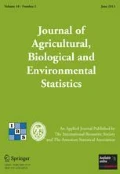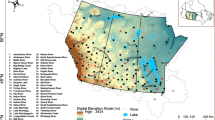Abstract
Rainfall is a critical component of climate governing vegetation growth and production, forage availability and quality for herbivores. However, reliable rainfall measurements are not always available, making it necessary to predict rainfall values for particular locations through time. Predicting rainfall in space and time can be a complex and challenging task, especially where the rain gauge network is sparse and measurements are not recorded consistently for all rain gauges, leading to many missing values. Here, we develop a flexible Bayesian model for predicting rainfall in space and time and apply it to Narok County, situated in southwestern Kenya, using data collected at 23 rain gauges from 1965 to 2015. Narok County encompasses the Maasai Mara ecosystem, the northern-most section of the Mara–Serengeti ecosystem, famous for its diverse and abundant large mammal populations and spectacular migration of enormous herds of wildebeest, zebra and Thomson’s gazelle. The model incorporates geographical and meteorological predictor variables, including elevation, distance to Lake Victoria and minimum temperature. Salient features of our model are the use of non-stationary covariance structures and the facility to handle excess zeros and many missing observations. We assess the efficiency of the model by comparing it empirically with the established Gaussian process, Kriging, simple linear and Bayesian linear models. We use the model to predict total monthly rainfall and its standard error for all 5 \(\times \) 5 km grid cells in Narok County for each year from 1965 to 2015. Using the Monte Carlo integration method, we estimate seasonal and annual rainfall and their standard errors for 29 sub-regions of Narok for each of the 51 years spanning 1965–2015. The non-stationary model can handle data from a sparse network of observations with many missing values and performs at least as well as or better than four established and widely used models on the Narok rainfall data set. The model produces rainfall predictions consistent with expectation and in good agreement with blended station and satellite rainfall values. The predictions are precise enough for most practical purposes. The model is very general and applicable to other variables besides rainfall.
Supplementary materials accompanying this paper appear online







Similar content being viewed by others
References
Allcroft, D. J., and Glasbey, C. A. (2003), “A latent Gaussian Markov random-field model for spatiotemporal rainfall disaggregation,” Journal of Royal Statistical Society, Series C, 52, 487–498.
Bakar, K. S., and Sahu, S. K. (2015), “spTimer: Spatio-Temporal Bayesian Modelling Using R,” Journal of Statistical Software, 63(15), 1–32.
Banerjee, S., Gelfand, A. E., Finley, A. O., and Sang, H. (2008), “Gaussian predictive process models for large spatial data sets,” Journal of Royal Statistical Society, Series B, 70, 825–848.
Bartzke, G. S., Ogutu, J. O., Mukhopadhyay, S., Mtui, D., Dublin, H. T., and Piepho, H. P. (2018), “Rainfall trends and variation in the Maasai Mara ecosystem and their implications for animal population and biodiversity dynamics,” PLoS ONE, 13(9), e0202814.
Boutton, T. W., Tieszen, L. L., and Imbamba, S. K. (1988a),“Biomass dynamics of grassland vegetation in Kenya,” AfricanJournal of Ecology, 26, 89–101.
Boutton, T. W., Tieszen, L. L., and Imbamba, S. K. (1988b),“Seasonal changes in the nutrient content of East Africangrassland vegetation,” African Journal of Ecology, 26(2), 103–115.
Briggs, W. M., and Levine, R. A. (1997), “Wavelets and field forecast verification,” Monthly Weather Review, 125(6), 1329–1341.
Brown, P. E., Diggle, P. J., Lord, M. E., and Young, P. C. (2001), “Space-time calibration of radar rainfall data,” Journal of Royal Statistical Society, Series C, 50(2), 221–241.
Chai, T., and Draxler, R. R. (2014), “Root mean square error (RMSE) or mean absolute error (MAE)?—Arguments against avoiding RMSE in the literature,” Geoscientific Model Development, 7, 1247–1250.
Coe, M. J., Cumming, D. H., and Phillipson, J. (1976), “Biomass and production of large African herbivores in relation to rainfall and primary production,” Oecologia, 22(4), 341–354.
Cressie, N. A. C., and Wikle, C. K. (2011), Statistics for Spatio-Temporal Data, New York: Wiley.
Deshmukh, I. K. (1984), “A common relationship between precipitation and grassland peak biomass for east and southern Africa,” African Journal of Ecology, 22, 181–186.
Dublin, H. T., and Ogutu, J. O. (2015), “Population regulation of African buffalo in the Mara–Serengeti ecosystem,” Wildlife Research, 42, 382–393.
East, R. (1984), “Rainfall, soil nutrient status and biomass of large African savanna mammals,” African Journal of Ecology, 22, 245–270.
Fritz, H., and Duncan, P. (1994), “On the carrying capacity for large ungulates of African savanna ecosystems,” Proceedings of Royal Society of London B, 256, 77–82.
Furrer, R., Nychka, D., and Sain, S. (2013), Fields: Tools for Spatial Data, University Corporation for Atmospheric Research. R package version 8.4.1. http://cran.r-project.org/web/packages/fields. Accessed 1 Nov 2017.
Georgiadis, N. J., and McNaughton, S. J. (1990), “Elemental and fibre contents of savanna grasses: variation with grazing, soil type, season and species,” Journal of Applied Ecology, 27, 623–634.
Hofer, H., and Campbell, K. (1995), People and Wildlife: Spatial Dynamics and Zones of Interaction, Chicago and London: The University of Chicago Press.
Lorenz, E., Jenkner, C., Sauerbrei, W., and Becher, H. (2017), “Modeling variables with a spike at zero: Examples and practical recommendations,” American Journal of Epidemiology, 185(8), 650–660.
McNaughton, S. J. (1985), “Ecology of a grazing ecosystem: The Serengeti,” Ecological monographs, 55, 259–294.
Mills, E. D. (2013), Adjusting for covariates in zero-inflated gamma and zero-inflated log-normal models for semicontinuous data,, Technical report, University of Iowa, Iowa Research Online, https://ir.uiowa.edu/etd/2583. Accessed 1 Nov 2017.
Mukhopadhyay, S., and Sahu, S. K. (2018), “A Bayesian spatio-temporal model to estimate long term exposure to outdoor air pollution at coarser administrative geographies in England and Wales,” Journal of Royal Statistical Society, Series A, 181(2), 465–486.
Norton-Griffiths, M., Herlocker, D., and Pennycuick, L. (1975), “The patterns of rainfall in the Serengeti ecosystem, Tanzania,” African Journal of Ecology, 13, 347–374.
Ogutu, J. O., and Owen-Smith, N. (2005), “Oscillations in large mammal populations: Are they related to predation or rainfall?,” African Journal of Ecology, 43, 332–339.
Ogutu, J. O., Piepho, H. P., and Dublin, H. T. (2014), “Responses of phenology, synchrony and fecundity of breeding by African ungulates to interannual variation in rainfall,” Wildlife Research, 40, 698–717.
Ogutu, J. O., Piepho, H. P., and Dublin, H. T. (2015), “Reproductive seasonality in African ungulates in relation to rainfall,” Wildlife Research, 41, 323–342.
Ogutu, J. O., Piepho, H. P., Dublin, H. T., Bhola, N., and Reid, R. S. (2008a), “El Niño Southern Oscillation, rainfall, temperature and Normalized Difference Vegetation Index fluctuations in the Mara–Serengeti ecosystem,” African Journal of Ecology, 46, 132–143.
Ogutu, J. O., Piepho, H. P., Dublin, H. T., Bhola, N., and Reid, R. S. (2008b), “Rainfall influences on ungulate population abundance in the Mara–Serengeti ecosystem,” Journal of Animal Ecology, 77, 814–829.
Ogutu, J. O., Piepho, H. P., Dublin, H. T., Bhola, N., and Reid, R. S. (2010), “Rainfall extremes explain interannual shifts in timing and synchrony of calving in topi and warthog,” Population Ecology, 52, 89–102.
Okuto, E. O. A. (2013), Bayesian spatial and spatio–temporal modelling (applied to precipitation dataset),, Technical Report I56/68975/2011, University of Nairobi, College of Biological and Physical Sciences, School of Mathematics.
Pennycuick, L., and Norton-Griffiths, M. (1976), “Fluctuations in the rainfall of the Serengeti ecosystem, Tanzania,” Journal of Biogeography, 3, 125–140.
Prins, H. H. T. (1988), “Plant phenology patterns in Lake Manyara National Park, Tanzania,” Journal of Biogeography, 15, 455–480.
Prins, H. H. T., and Loth, P. E. (1988), “Rainfall pattern as background to plant phenology in northern Tanzania,” Journal of Biogeography, 15, 451–463.
Ritchie, M. E. (2008), Global environmental changes and their impact on the Serengeti.Serengeti III: human impacts on ecosystem dynamics, Chicago and London: The University of Chicago Press.
Sahu, S. K., and Bakar, K. S. (2012), “A comparison of bayesian models for daily ozone concentration levels,” Statistical Methodology, 9(1), 144–157.
Sahu, S. K., and Challenor, P. (2008), “A space-time model for joint modeling of ocean temperature and salinity levels as measured by Argo floats,” Environmetrics, 19, 509–528.
Sahu, S. K., Gelfand, A. E., and Holland, D. M. (2006), “Spatio-temporal modeling of fine particulate matter,” Journal of Agricultural, Biological, and Environmental Statistics, 11, 61–86.
Sahu, S. K., Gelfand, A. E., and Holland, D. M. (2007), “High-resolution space-time ozone modeling for assessing trends,” Journal of the American Statistical Association, 102, 1221–1234.
Sahu, S. K., Lasinio, G. J., Orasi, A., and Mardia, K. V. (2001), “A comparison of spatio-temporal bayesian models for reconstruction of rainfall fields in a cloud seeding experiment,” Journal of Mathematics and Statistics, 1(4), 282–290.
Sahu, S. K., and Mukhopadhyay, S. (2015), On generating a flexible class of anisotropic spatial models using Gaussian predictive processes,, Technical report, University of Southampton.
Sansó, B., and Guenni, L. (1999), “Venezuelan rainfall data analysed by using a Bayesian space-time model,” Journal of Royal Statistical Society, Series C, 48, 345–362.
Simpson, D., Rue, H., Riebler, A., Martins, T. G., and Sørbye, S. H. (2017), “Penalising model component complexity: a principled, practical approach to constructing priors,” Statistical Science, 32(1), 1–28.
Sinclair, A. R. E. (1975), “The resource limitation of trophic levels in tropical grassland ecosystems,” The Journal of Animal Ecology, 44, 497–520.
Sinclair, A. R. E., Mduma, S. A., and Arcese, P. (2000), “What determines phenology and synchrony of ungulate breeding in Serengeti?,” Ecology, 81, 2100–2111.
Tobin, J. (1958), “Estimation of relationships for limited dependent variables,” Econometrica, 6(1), 24–36.
Willmott, C. J., and Matsuura, K. (2005), “Advantages of the mean absolute error (MAE) over the root mean square error (RMSE) in assessing average model performance,” Climate Research, 30, 79–82.
Zhang, H. (2004), “Inconsistent estimation and asymptotically equal interpolations in model-based geostatistics,” Journal of the American Statistical Association, 99, 250–261.
Acknowledgements
We thank the Associate Editor and two anonymous referees for very helpful and constructive comments and suggestions that helped improve earlier drafts of this paper. We gratefully thank Professor Kay E. Holekamp (Michigan State University) and the Kenya Meteorological Department (KMD) for providing the rainfall data as well as helpful advice. In particular, we are greatly indebted to Ms Christine Mahonga for her patience and excellent support in making the data available to us and coordinating the verification of the rainfall data at KMD. We are grateful to Mr. Gordon Ojwang (Directorate of Resource Surveys and Remote Sensing of Kenya) for his assistance in acquiring the data and to Chris Shitote of FEWS NET for his help in extracting the blended satellite-station rainfall and temperature data from the GEOCLIM TOOL. We are also grateful to Professor Sujit K. Sahu (University of Southampton) for suggestions that helped improve the spatio-temporal model and to Professor Norman Owen-Smith (University of the Witwatersrand) for providing valuable insights on understanding the rainfall pattern in Narok. JOO was supported by a grant from the German Research Foundation (Grant No. OG 83/1-1). This project has received funding from the European Union Horizon 2020 research and innovation programme under Grant Agreement No. 641918.
Author information
Authors and Affiliations
Corresponding author
Additional information
Publisher's Note
Springer Nature remains neutral with regard to jurisdictional claims in published maps and institutional affiliations.
Electronic supplementary material
Below is the link to the electronic supplementary material.
Rights and permissions
About this article
Cite this article
Mukhopadhyay, S., Ogutu, J.O., Bartzke, G. et al. Modelling Spatio-Temporal Variation in Sparse Rainfall Data Using a Hierarchical Bayesian Regression Model. JABES 24, 369–393 (2019). https://doi.org/10.1007/s13253-019-00357-3
Received:
Accepted:
Published:
Issue Date:
DOI: https://doi.org/10.1007/s13253-019-00357-3




